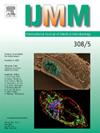Assessing potential misidentification of Staphylococcus argenteus as Staphylococcus aureus in clinical routine samples: A retrospective study
IF 3.6
3区 医学
Q1 MICROBIOLOGY
引用次数: 0
Abstract
Staphylococcus argenteus is a recently described member of the Staphylococcus aureus complex. Thus far, its frequency in clinical samples has been rarely described. Following an update of the commercially available matrix-assisted laser desorption/ionisation time-of-flight mass spectrometry (MALDI-TOF MS) database (Bruker Daltonics) for pathogen identification, isolates from our S. aureus biobank were reanalysed for the detection of potentially misdiagnosed S. argenteus isolates. Additionally, we assessed whether phenotypical characteristics can be used to differentiate between S. aureus and S. argenteus in routine microbiological diagnostics. Among 505 investigated isolates, no S. argenteus or another member of the S. aureus complex were found. Furthermore, the morphological difference could not reliably distinguish between S. aureus and S. argenteus, as the latter was significantly more often missed by the staff in our study. Continuous surveillance of S. argenteus is essential to more accurately understand its epidemiology.
评估临床常规样本中将阿根廷葡萄球菌误认为金黄色葡萄球菌的可能性:一项回顾性研究
阿根廷葡萄球菌是最近发现的金黄色葡萄球菌复合体的成员。到目前为止,其在临床样本中的频率很少被描述。在更新了用于病原体鉴定的市售基质辅助激光解吸/电离飞行时间质谱(MALDI-TOF MS)数据库(Bruker Daltonics)之后,我们对金黄色葡萄球菌生物库中的分离物进行了重新分析,以检测可能被误诊的金黄色葡萄球菌分离物。此外,我们评估了表型特征是否可以用于区分金黄色葡萄球菌和阿根廷葡萄球菌的常规微生物诊断。在505株被调查的分离株中,未发现阿根廷葡萄球菌或金黄色葡萄球菌复合体的其他成员。此外,形态差异不能可靠地区分金黄色葡萄球菌和阿根廷葡萄球菌,因为后者在我们的研究中更容易被工作人员遗漏。对阿根廷葡萄球菌的持续监测对于更准确地了解其流行病学至关重要。
本文章由计算机程序翻译,如有差异,请以英文原文为准。
求助全文
约1分钟内获得全文
求助全文
来源期刊
CiteScore
9.70
自引率
0.00%
发文量
18
审稿时长
45 days
期刊介绍:
Pathogen genome sequencing projects have provided a wealth of data that need to be set in context to pathogenicity and the outcome of infections. In addition, the interplay between a pathogen and its host cell has become increasingly important to understand and interfere with diseases caused by microbial pathogens. IJMM meets these needs by focussing on genome and proteome analyses, studies dealing with the molecular mechanisms of pathogenicity and the evolution of pathogenic agents, the interactions between pathogens and host cells ("cellular microbiology"), and molecular epidemiology. To help the reader keeping up with the rapidly evolving new findings in the field of medical microbiology, IJMM publishes original articles, case studies and topical, state-of-the-art mini-reviews in a well balanced fashion. All articles are strictly peer-reviewed. Important topics are reinforced by 2 special issues per year dedicated to a particular theme. Finally, at irregular intervals, current opinions on recent or future developments in medical microbiology are presented in an editorial section.

 求助内容:
求助内容: 应助结果提醒方式:
应助结果提醒方式:


